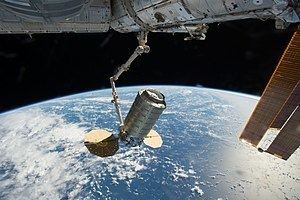Mission type ISS resupply Spacecraft type Enhanced Cygnus Contractor Orbital ATK Inclination 51.62° Perigee 213,000 m Rocket Antares | Operator NASA Launch site MARS LP-0A Reference system Geocentric Apogee 361,000 m Launch date 17 October 2016 | |
 | ||
Manufacturers Orbital ATK, Thales Alenia Space Similar Cygnus, Progress MS‑03, Progress MS‑02, Kounotori 6, Progress MS‑04 | ||
Nasa launch of cygnus crs oa 5
Cygnus CRS OA-5, also known as Orbital Sciences CRS Flight 5, is the seventh planned flight of the Orbital Sciences' unmanned resupply spacecraft Cygnus and its sixth flight to the International Space Station under the Commercial Resupply Services contract with NASA. Orbital and NASA jointly developed a new space transportation system to provide commercial cargo resupply services to the International Space Station (ISS). Under the Commercial Orbital Transportation System (COTS) program, Orbital designed and built Antares, a medium-class launch vehicle; Cygnus, an advanced maneuvering spacecraft, and a Pressurized Cargo Module which is provided by Orbital's industrial partner Thales Alenia Space.
Contents
The Cygnus spacecraft for this mission is named the S.S. Alan Poindexter in honor to astronaut Alan G. Poindexter, a deceased space shuttle commander. Poindexter was selected in the 1998 NASA Group (G17) and went into orbit aboard Space Shuttle Missions STS-122, and STS-131
History
The COTS demonstration mission was successfully conducted in September 2013, and Orbital commenced operational ISS cargo missions under the Commercial Resupply Service (CRS) program with two missions in 2014. Regrettably, the third operational mission, Orb CRS-3, was not successful due to spectacular Antares failure during launch. The company decided to discontinue the Antares 100 series and accelerate the introduction of a new propulsion system. The Antares system is being upgraded with newly built RD-181 first stage engines to provide greater payload performance and increased reliability.
In late 2014 Orbital contracted United Launch Alliance for an Atlas V launch of Orb OA-4 in late 2015 from Cape Canaveral, FL, and with a second Atlas V launch of Cygnus in 2016. The company plans three Cygnus missions in 2016, in the first (CRS OA-6), third (CRS OA-5) and fourth quarters (CRS OA-7) of 2016. The Cygnus OA-5 and OA-7 will fly on the new Antares 230 and OA-6 will fly on second Atlas V in first quarter of 2016. These three missions enable Orbital ATK to fulfill their CRS contracted payload obligation. This particular mission is known as OA-5.
Production and integration of Cygnus spacecraft is performed in Dulles, VA. The Cygnus service module is mated with the pressurized cargo module at the launch site, and mission operations are conducted from control centers in Dulles and Houston.
Spacecraft
This is the sixth of ten flights by Orbital Sciences under the Commercial Resupply Services contract with NASA. This will be the third flight of the Enhanced sized Cygnus PCM. The mission successfully launched on 17 October 2016, 23:45 UTC (17 October 2016, 19:45 EDT).
In keeping with an Orbital Sciences tradition, this Cygnus spacecraft is named the S.S. Alan Poindexter after the NASA astronaut who flew aboard the Space Shuttle twice (2008 & 2010).
Manifest
Other OA projects
NASA had planned the next Cygnus flight, OA-7, for December 30, 2016. However, in October 2016, it was announced that OA-7 was being delayed until March 2017 and switched from the Antares launch vehicle to a United Launch Alliance Atlas V rocket to provide additional cargo up mass for NASA.
In 2015, under the NASA CRS-1 contract, Orbital was awarded three extension flights for 2017 and 2018. The OA-8E flight has tentatively been scheduled for June 12, 2017, followed by OA-9E later that year and OA-10E in 2018. Cargo vehicle scheduling is dynamic with the ISS partners. The schedule will be influenced by the first USA manned commercial flights (SpaceX, Boeing) to ISS since Space Shuttle retirement in 2011.
Cubesat release
On November 25, 2016, after leaving the ISS, the spacecraft raised its orbit to 500 kilometers and released four Lemur-2 cubesats for Spire Global.
